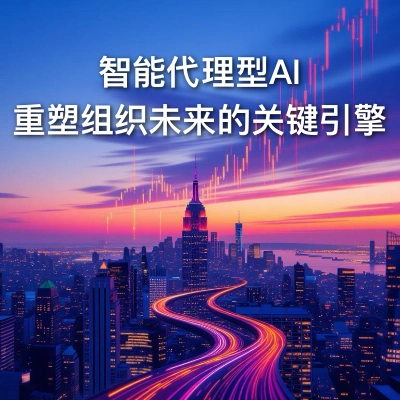Table of Contents

一、智能代理型AI的崛起:突破传统的边界
企业对新技术的响应,常常停留于流程微调或简单工具加装。然而,令人瞩目的下一代人工智能浪潮——Agentic AI(智能代理型AI) 正以更高的要求推动企业整体重组。这不仅要求技术创新,更需要组织结构和协作模式发生根本性变革。
什么是智能代理型AI?
智能代理型AI不仅是“可以对话的机器人”,而是由一批具备自主计划、推理和行动能力的AI代理组成的系统。它们能跨部门协调、自动决策、整合分散数据和系统,成为企业“数字同事”团队:
- 专家代理:如代码助手、智能助理
- 协调代理:整合并编排众多专家行为
- 系统协奏:AI代理如同“智能中枢”,跨系统、跨流程操作,自动适应变化
智能代理AI不强迫数据或流程“大一统”,可灵活协调碎片化系统,显著提升流程流畅度。相比以往“硬编码、死板规则”的自动化机制,Agentic AI更擅长应对动态变化和高复杂度场景。
二、成功案例:日立数字的“智能HR大脑”
项目亮点
日立数字把 Agentic AI 应用在人力资源(HR)运营。面对20多个独立HR系统和分散的业务平台,传统迁移成本高、复杂性大,日立采用了“代理型工作流”:
- 员工通过AI助手“Skye”提出问题(如薪酬、假期、IT支持等)
- Skye 拆解意图、派发给对应AI代理:如政策查询、请假流程、IT报修、薪资咨询等
- 代理自动完成信息采集、表单填报、审批流转,复杂事务推送人工决策
结果,大幅简化了员工体验,HR团队从繁琐事务中解放出来,专注于战略任务。
三、从任务到成果:业务变革的跃迁

Agentic AI的独特之处,在于从“完成任务”转向“达成成果”。不仅能自动回复客户,也能统计、分析海量客服对话,敏锐发现共性问题、提出预防方案、发起修复请求——实现质量管理和持续优化闭环。
案例参考:
- 客服海量对话自动分析,识别重复性的物流滞后,主动切换供应商
- 某IT服务企业,RFP(需求响应)流程AI化,将原本20人周级任务缩短至几分钟,显著提效
关键原则:
- 以成果为导向——设立“使命负责人”:由专人定义终极目标,统筹AI与人力,确保关键结果达成。
- 打通数据壁垒——明晰业务逻辑:AI可横跨多个异构系统,“流程映射”、“业务语义清晰”比数据完全统一更重要。
- 领导力与治理——设定适当边界与信任:培养全员AI素养,让人人懂“数字同事”,建立流程可审计、行为可追溯的治理体系。
四、实践三步法:组织如何迈向“代理智能”未来
1. 聚焦高摩擦的流程切入
挑选一个任务复杂、跨部门的核心流程(如客户支持、订单履约等),为其设定清晰的“成果定义”,委任一位“使命负责人”,推动横向协作。
2. 数据不是障碍,业务语义为王

不用等到“大一统”数据平台成熟。AI代理可通过接口联动各系统,前提是流程/规则清楚,决策逻辑易推理。
3. 构建信任与管控体系
领导示范,让AI不再“神秘”。员工参与设计和部署,过程充分透明。设立监控与变更机制,让AI代理在“信任-监督”交替中成长。
五、组织转型的价值升维
组织若能围绕成果重组,并以Agentic AI为乐高积木般搭建智能化工作台,将获得:
- 质的客户体验提升:问题主动预防、服务按需延展
- 流程提效和成本下降:AI承担繁琐,“人”专注高阶决策
- 数据资产与知识体系不断完善:流程标准化反哺信息化
- 创新与响应速度指数级提升
正如本文总结:组织能否抓住这波智能代理型AI浪潮,已不仅关乎效率或成本,更将决定其在未来商业格局中的话语权。
未来已来,行动正当时
那些率先以智能代理AI重塑使命、流程与信任机制的企业,将书写下一代企业运营与增长的蓝图。
Agentic AI—Redefining Enterprise Operations for a New Era
Topic Focus: How agentic, autonomous AI systems are transforming the way organizations deliver value, structure teams, and compete in a complex, data-rich world.
1. Introduction: Agentic AI as a Catalyst for Organizational Change
Whenever disruptive technologies emerge, some companies simply tinker, while others leap ahead by reimagining how they work. With the rise of agentic AI—networks of autonomous digital agents capable of complex reasoning and cross-functional collaboration—the stakes are higher than ever. These agents aren’t just “better bots”—they’re programmable collaborators that can plan, coordinate, and act across fragmented structures, demanding a corresponding organizational transformation.
What is Agentic AI?
At its core, agentic AI is a constellation of specialized digital agents, each with capabilities around planning, making judgments, and executing instructions. Some agents operate as domain experts—solving coding challenges or fielding HR questions—while others orchestrate actions, bringing specialists together to accomplish broader business outcomes.
Crucially, agentic AI integrates disparate data sources and software, enabling seamless, goal-driven operations without imposing monolithic system migrations. Unlike old-school automation tools hard-coded to handle only routine tasks, agentic AI excels at navigating exceptions, learning, and adapting as business conditions change.
2. Case Insight: Smart HR with Agentic AI at Hitachi Digital
Faced with sprawling HR records, diverse payroll systems, and multiple IT tools, Hitachi Digital chose not to standardize all data but instead implemented an agentic AI “knowledge and action” fabric.
How it Works:
- An AI assistant named “Skye” receives and classifies employee inquiries—ranging from travel expense rules to IT support requests.
- Each inquiry is routed to an expert agent: for example, a document generator creates employment verification letters, a leave manager interfaces with HR systems for vacation approvals, and IT agents open and follow up on technical support tickets.
- This networked intelligence simplifies what used to be a labyrinth of disjointed processes, empowering human teams to focus on strategic initiatives instead of repetitive troubleshooting.
3. Beyond Tasks: From Transaction to Transformation
The magic of agentic AI lies in making business “outcomes” the organizing principle—rather than individual tasks or ticket closures. Not only do these digital agents resolve employee and customer issues, they can also surface widespread problems, analyze interactions at scale, and even anticipate and remediate root causes.
Industry Examples:
- In logistics, agentic AI tracks shipping holdups, coordinates with external carriers, and issues refunds or replacements autonomously.
- At service firms, the AI drafts complex RFP responses in minutes, freeing human staff for high-level refinement and customer engagement.
Key Principles for Success:
- Outcome-Driven Structure: Appoint clear mission owners to define, steer, and measure agent-AI/human hybrid achievements.
- Interconnected Data & Logic: Rather than centralized data, ensure well-mapped workflows and modular business rules, accessible by API, so agents find and act on the right context.
- Leadership & Guardrails: Embed organizational literacy in AI collaboration; foster trust with transparent operation, tiered oversight, and the right escalation paths.
4. A Roadmap for Agentic AI Maturity
Step 1: Identify Friction Points
Target a customer or employee journey that suffers from delays, handoffs, or information fragmentation. Define a mission and outcome metric, then break down the critical workflows involved.
Step 2: Build on Current Systems, Not Perfect Data
Leverage existing APIs and data silos as-is. What matters is the clarity of processes, decisions, and exception handling, not absolute data centralization.
Step 3: Instill Trust, Literacy, and Oversight
Train staff to understand how digital agents operate, when human input is necessary, and how to monitor agent-driven outcomes. Governance should rely on real-time monitoring, auditable logs, and layered authority—managers, IT, legal—all collaborating in system design and risk management.
5. The Transformative Payoff
Organizations willing to center around outcomes and experiment with agentic AI systems are discovering tangible advantages:
- Superior Customer and Employee Experiences: Issues are anticipated and prevented, not simply resolved after escalation.
- Radically Improved Efficiency: Routine work is automated, freeing people to focus on complex creative and relational tasks.
- Enhanced Knowledge & Data Utilization: Standardized workflows and better information hygiene support ongoing process improvement.
- Faster Innovation: Organizations become more responsive, adaptive, and competitive.
As agentic AI matures, those pioneering new blueprints around it won’t just optimize individual processes—they’ll redefine the very nature of modern work and enterprise value creation.
The Next Frontier: Act Now, Build for the Future
The future belongs to those organizations that reorganize around mission-ownership, integrated digital-human teams, and outcome-centric processes—powered by the intelligence and adaptability of next-generation AI agents.
